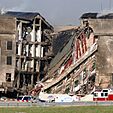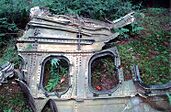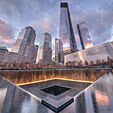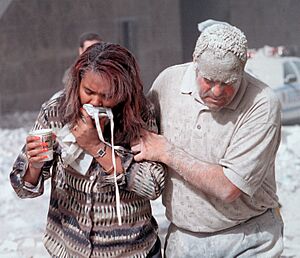Casualties of the September 11 attacks facts for kids
- From top, left to right: Flight 175 hits the South Tower
- Rescue workers at Ground Zero
- Collapsed section of the Pentagon
- Fragment of the Flight 93 fuselage
- 9/11 Memorial reflecting pool and One World Trade Center
The September 11 attacks were a series of terrible terrorist attacks that happened on September 11, 2001. They caused the deaths of 2,996 people. This included 2,977 victims and 19 hijackers who committed the attacks. Thousands more people were hurt. Many also suffered long-term health problems because of the attacks.
New York City was hit the hardest. The Twin Towers in Lower Manhattan were attacked. About 1,600 people died in the North Tower. Around 1,000 people died in the South Tower. In Arlington County, Virginia, 125 people were killed at the Pentagon. The remaining 265 deaths were passengers and crew on four hijacked planes: American Airlines Flight 11, United Airlines Flight 175, American Airlines Flight 77, and United Airlines Flight 93. The attack on the North Tower alone was the deadliest act of terrorism in history.
Most of the people who died were regular citizens. However, 343 members of the New York City Fire Department and 71 law enforcement officers died in New York City. A U.S. Fish and Wildlife Service officer died when Flight 93 crashed in Shanksville, Pennsylvania. Also, 55 military personnel died at the Pentagon. People from at least 102 different countries lost their lives in these attacks.
In 2007, New York City started adding people to the official death toll. These were people who died later from illnesses caused by breathing in dust from the attack sites. By 2011, the total number of victims from the World Trade Center site reached 2,606. This brought the overall 9/11 death toll to 2,996. By 2013, over 1,140 people who lived or worked near the World Trade Center were diagnosed with cancer. This was due to "toxins at Ground Zero." In 2014, reports showed that over 1,400 rescue workers had died since the attacks.
Contents
Escaping the Attacks
Most tall buildings in the U.S. were not made for everyone to leave during a crisis. This was true even after the 1993 World Trade Center bombing. Building rules often said people should stay in their offices unless fire was very close. After the 1993 attack, it took ten hours to get everyone out of the towers. So, new plans and changes were made. Radio systems were put in to help with communication. Battery-powered emergency lights were added. Fire drills were also held.
People who escaped both the 1993 and 2001 attacks said they were better prepared in 2001. Some even brought flashlights or emergency bags with them. Each of the 110-story Twin Towers had three stairwells in the middle. These stairwells were very tall, going all the way down.

Right after the attacks, some news reports thought tens of thousands might have died. But estimates show that between 14,000 and 19,000 people were in the Twin Towers that morning. The National Institute of Standards and Technology (NIST) said about 17,400 civilians were in the World Trade Center complex.
Almost all deaths in the Twin Towers happened on floors hit by the planes. It's not known exactly how many people were on those floors. Data suggests that between 1,344 and 1,426 people were on floors 92–110 of the North Tower. None of them survived after American Airlines Flight 11 crashed there at 8:46 AM. In the South Tower, about 599 to 690 people were on floors 77–110. Only 18 of them survived after United Airlines Flight 175 hit at 9:03 AM.
Researchers found that only about 8.6% of survivors left right away. Most waited for more information or did other tasks, like collecting things or calling family. Also, 82% of those leaving stopped at least once. This was due to crowded stairs, needing a rest, or bad conditions like smoke. The plane impacts also caused doors to jam and stairwells to be blocked. This trapped many people, especially near where the planes hit. Communication was also difficult. 911 operators were overwhelmed and sometimes gave wrong information. First responders also had trouble communicating because their radios were on different channels or overwhelmed.
North Tower Evacuation
After Flight 11 hit, the Port Authority ordered everyone in the North Tower to leave. Only those below the 92nd floor could follow this order. About 8,000 people could go down. But the towers were not built for so many people to leave at once. Each tower had only three stairwells. For anyone above the 91st floor, escape was impossible. One victim called 911 saying the stairs were blocked from the 106th floor.
A study after the attacks estimated it would take about 1 hour and 27 minutes for 8,239 people to leave the tower. A team of Port Authority officers helped free at least 77 people from floors 88 to 90. Emergency responders arrived quickly and started helping people get out.
Many people started leaving on their own using the stairs. Others waited for instructions. Some were encouraged to leave by family members they contacted. People leaving the North Tower were told to go to the underground shopping area. From there, they could exit onto Church Street. Some survivors also used the "Survivors' Staircase," an outdoor staircase that stayed standing.
South Tower Evacuation

In the South Tower, almost all 8,600 people knew something serious had happened next door. The sound of the first plane hitting the North Tower was heard by over 4,000 people. Some saw the fireballs from the crash. Debris hit the South Tower's northern and western sides. Many people saw others jumping from the burning North Tower. Smoke from the North Tower also entered the South Tower through air vents. Those on the same floors as the fires felt extreme heat. News, phone calls, and word of mouth quickly spread how serious the situation was. Half of the people in the South Tower felt their lives were in danger.
Many people in the South Tower started leaving as a precaution. However, for 17 minutes between the two plane impacts, it wasn't clear it was a terrorist attack. Most thought the first crash was an accident. Because of this, the Port Authority in the South Tower did not order a full evacuation. Instead, they used the intercom system and security guards to tell workers to stay in their offices. A deliveryman heard a message saying, "The building is secure. The safest place is inside; stay calm and do not leave." Officials in the lobby also told people trying to leave to go back to their floors. This was done to avoid overcrowding, which could slow down rescue efforts in the North Tower.
Despite these announcements, thousands continued to leave the South Tower. Over 3,500 people were on floors 77 to 110. Companies like AON Insurance and Fiduciary Trust had offices there. Their leaders quickly ordered their employees to evacuate. This allowed over 80% of their workers to get to safety before the South Tower was hit. Other companies also evacuated their offices. Executives told employees to take the stairs to the 78th floor Skylobby. From there, they could take a fast elevator to the ground. In just 17 minutes, about 2,900 people got below the 77th floor of the South Tower. Between 599 and 690 people did not.
By 8:57 AM, fire and police officials said the whole World Trade Center complex was unsafe. They asked for the South Tower to be evacuated. This advice took six more minutes to be put into action. By 9:02 AM, an announcement was made, giving workers the option to leave.
Pentagon Evacuation
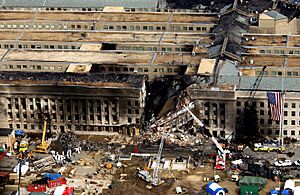
The the Pentagon was hit after the World Trade Center. Many people working there didn't think the attacks would reach Washington D.C. One worker said, "This is the safest place to be in the world right now." Another was on the phone with his wife and her sixth-grade class when the plane hit. He said the whole building felt like it was lifted off its foundation. He hung up saying, "We've been bombed, I have to go," and started to leave. People were careful evacuating. One security guard even warned about possible shooters.
World Trade Center Hotel Evacuation
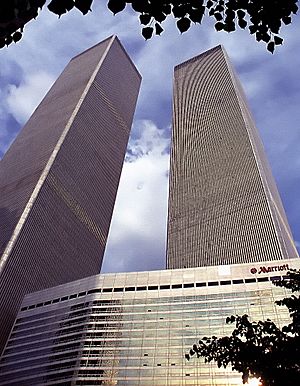
World Trade Center 3 was also known as the Marriott Hotel. This 22-story hotel was used to help about 1,000 people escape the area. Hotel staff guided guests through the hotel's bar and out onto Liberty Street. A police officer held the door, sometimes stopping people due to falling debris or bodies. A paramedic helping remembered the air being so hot and thick it was hard to breathe or see. He could hear alarms from firefighters who had collapsed.
Most of the 940 guests at the hotel started leaving after alarms went off. This happened when a piece of a plane's landing gear landed on the pool's top floor. Some guests didn't leave right away. One guest woke up when the first plane hit, went back to bed, and then woke up again when the second plane hit. He watched the news, showered, got dressed, and gathered his things before leaving after the South Tower fell. Many guests couldn't see the damage to the North Tower from the Marriott.
Evacuation of the Surrounding Area
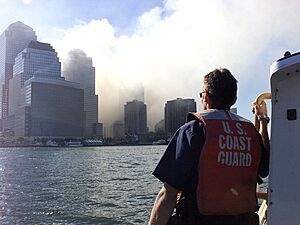
Once both towers were hit, the order to evacuate spread. It included the entire World Trade Center complex and most tall buildings in Lower Manhattan. People leaving the North Tower went through the underground shopping mall to Church Street. Those from the South Tower were sent elsewhere to avoid crowding. They went across a bridge to the World Financial Center or to 4 World Trade Center and out onto Liberty Street. Not only workers, but also students from Stuyvesant High School and Borough of Manhattan Community College, tourists, and local residents were part of the evacuation.
To help clear the city, boats and ferries were used to evacuate Lower Manhattan by water. Some boats belonged to the United States Coast Guard. Others were civilian or company-owned. They helped after the Coast Guard asked for all available boats. One crew heard the call: "All available boats....This is the United States Coast Guard…. Anyone wanting to help with the evacuation of Lower Manhattan report to Governors Island." In total, about 500,000 people were moved by water that day.
Disabled Individuals Evacuation
On the day of the attacks, some people with disabilities were in the World Trade Center. After the 1993 attack, a new evacuation plan was made. Some disabled people had been told to wait for rescuers, and some waited up to nine hours. This time, some were able to get out. John Abruzzo, who uses a wheelchair, was carried by coworkers from the 69th floor in an evacuation chair. It took them about 90 minutes to reach the ground. About 125 such chairs were bought after the 1993 bombing. However, training and communication about them varied. Michael Hingson, who is blind, was able to leave the 78th floor of the North Tower with his guide dog Roselle.
Survivors of the Attacks

No one survived in, above, or right below the North Tower's impact zone. The highest survivors came from Floor 91. About 15 people from below and on floor 22 survived the collapse of WTC 1. They later escaped or were rescued from the rubble.
At least 19 people are believed to have escaped from or above the South Tower's impact zone (floors 77 to 85). This was after it was hit by United Airlines Flight 175 at 9:03 AM. The highest survivor came from floor 98. People escaped using stairwell A in the northwest corner. This was the only stairwell left mostly intact after the plane hit. Investigators think stairwell A was usable until the South Tower collapsed at 9:59 AM. Because of communication problems, most 911 operators and responders didn't know stairwell A was open. They told survivors above the impact zone to wait for help.
After the Collapses
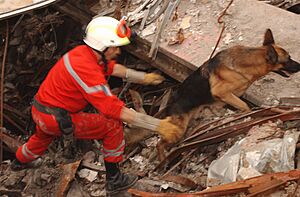
After the towers fell, only 20 people who were inside or below the towers escaped the debris. This included 12 firefighters and three Port Authority police officers. Only 16 people who were inside the collapsing North Tower survived and were rescued. They were all trying to leave using stairwell B. Four people in the concourse area between the Twin Towers survived. No one who was in the South Tower when it collapsed survived. The last survivor was found in the North Tower's ruins 27 hours after it fell.
An unknown number of others survived the first collapse. But they were buried deep in air pockets under the rubble and couldn't be rescued in time. Some were able to rescue themselves and others by climbing or digging through the rubble.
Support for Survivors
As of 2008, over 33,000 police officers, firefighters, and others were treated for injuries and illnesses from the 9/11 attacks in New York City. These included breathing problems, mental health issues like PTSD and depression, stomach problems, and over 4,166 cases of cancer. One group said "more cops have died of illness linked to the attack than had perished in it."
Former Daily Show host Jon Stewart and others worked to pass a law in 2015. This law permanently gives health care benefits to responders. It also added five years to the victims' compensation program. Stewart continued to speak out in 2019. He told Congress that 9/11 first responders were "Sick and dying" and that it was "Shameful" that they didn't have proper health care.
Victims of the Attacks
2,606 people who were in the World Trade Center and on the ground died because of the attacks and the towers collapsing. This number included 2,192 regular citizens, 343 firefighters, and 71 law enforcement officers. Among them was a bomb-sniffing dog named Sirius.
The average age of those who died in New York City was 40. The youngest victim was Christine Lee Hanson, a two-and-a-half-year-old girl on Flight 175. The oldest was Robert Norton, an 85-year-old on Flight 11. In the buildings, the youngest was 18-year-old Richard Allen Pearlman, a volunteer medic. The oldest was Albert Joseph, a 79-year-old maintenance worker. Ten pregnant women and their unborn babies also died.
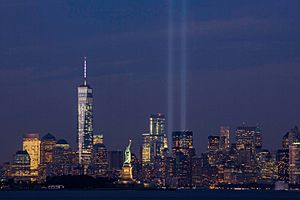
Other notable victims included photojournalist Bill Biggart, actor Keith A. Glascoe, and Hall of Fame lacrosse player Eamon McEneaney.
World Trade Center Victims
North Tower Deaths
The exact number of people killed in the North Tower isn't fully known. But it's thought to be around 1,600. Between 1,344 and 1,426 of these people were above the 91st floor when Flight 11 hit between floors 93 and 99 at 8:46 AM. Hundreds died instantly from the impact or the fire. Some were burned far below as jet fuel went down elevator shafts and exploded. Over 800 people were believed to have survived the first crash but were trapped. All stairwells in the impact zone were blocked. 70 people on floor 92, just below the impact, were also trapped. Those trapped died from smoke, fire, jumping, or the collapse. No one from the trapped floors was found alive in the rubble. As of 2021, the remains of 1,106 victims still haven't been identified.
John P. O'Neill, a former FBI assistant director, was killed trying to rescue people from the North Tower. He was head of security at the World Trade Center. Neil David Levin, the executive director of the Port Authority, was eating breakfast in the Windows on the World restaurant. Cantor Fitzgerald L.P., an investment bank, lost 658 employees. Marsh Inc., located below Cantor Fitzgerald, lost 295 employees.
South Tower Deaths
The exact number of people killed in the South Tower is also not fully known. But it's believed around 1,000 civilians and emergency workers died there. The NIST estimated that between 630 and 701 of these were WTC employees. Most were from floors trapped by the impact. If the South Tower had been hit first, it would have been deadlier. Over 3,500 people were on floors 77 or higher at 8:46 AM. But the 17-minute gap between the two impacts meant this number was much lower by 9:03 AM. Over 300 people died instantly from the crash. Two-thirds of these were from the 78th floor sky lobby.
Those who remained were not completely trapped, but almost all still died. The causes of death were similar to the North Tower, but fewer people jumped. 18 people from the impact zone escaped using Stairwell A. This was the only stairwell mostly intact and usable. The 9/11 Commission noted that few employees died below the 77th floor. This showed that evacuation below the impact zones was successful.
Morgan Stanley's security director Rick Rescorla died in the South Tower's collapse. He went back in to rescue others. After the 1993 bombing, Rescorla thought planes might be used as weapons against the World Trade Center. He suspected Flight 11 was deliberate and ordered Morgan Stanley's offices to evacuate. Morgan Stanley lost very few employees. Welles Crowther, a volunteer firefighter, also died helping others escape. He saved as many as 18 people. Even though Aon evacuated their offices, they still lost 175 employees.
World Trade Center Hotel Deaths

There's no exact number of deaths in the hotel. Many who took shelter there were protected by strong beams added after the 1993 bombing. However, pieces of the South Tower caused huge damage to the hotel. Survivors said the hotel was cut in half. Hotel employees protected by beams were told to leave. Firefighters stayed to dig out those covered by debris. After the North Tower collapsed, more debris crushed and killed those stuck. This included two hotel employees. Also, at least 41 firefighters and 11 hotel guests died.
Deaths in Elevators
One report estimated about 200 people died inside elevators. Only 21 escaped them. However, it was later found that 16% of South Tower evacuees used an elevator. Simulations suggest elevators saved about 3,000 people in the South Tower. Many elevators didn't fall when the planes hit. Instead, they got stuck, trapping people inside. Safety features meant to stop people from falling down shafts actually trapped them. One survivor had to pry open a small gap to escape. Another group was trapped for an hour and a half. They pried open the doors and dug through a wall to escape.
Conspiracy Theories
Some conspiracy theories claim Jewish people were warned not to go to work that day. However, between 270 and 400 Jewish people died in the attacks. This is based on the last names of the victims.
Pentagon Victims

At least 125 people working at the Pentagon were killed. Most worked for the United States Army or the United States Navy. Of these, 70 were civilians and 55 were military members. Lieutenant General Timothy Maude was the highest-ranking military official killed at the Pentagon.
Victims on the Four Planes
265 people died on the four planes. This included:
- 87 civilians (11 crew) and 5 hijackers on American Airlines Flight 11.
- 60 civilians (9 crew) and 5 hijackers on United Airlines Flight 175.
- 59 civilians (6 crew) and 5 hijackers on American Airlines Flight 77.
- 39 civilians (7 crew), a U.S. Fish and Wildlife Service officer, and 4 hijackers on United Airlines Flight 93.
Eight children died: five on Flight 77 (aged 3 to 11) and three on Flight 175 (aged 2, 3, and 4). The youngest victim was two and a half years old. The oldest was an 85-year-old passenger.
Notable passengers killed on Flight 11 included TV producer David Angell and actress Berry Berenson. Ice hockey players Garnet Bailey and Mark Bavis were on Flight 175. Physicist William E. Caswell and political commentator Barbara Olson were on Flight 77.

Foreign Victims

Besides the 19 attackers, at least 372 people from 102 countries died. The attackers were from Saudi Arabia (15), UAE (2), Egypt (1), and Lebanon (1).
Deaths After the Attacks
After the towers fell, a lot of toxic dust, debris, and ash was in the air around Ground Zero. This caused long-term health problems. Toxic materials like asbestos, lead, and mercury were present. Many victims and first responders didn't wear masks.
In 2018, it was reported that at least 15 FBI agents had died from cancer. This was due to their work after the attack. A medical director reported that over 2,000 of the 10,000 first responders and others who developed cancer had died from 9/11-related illnesses. The Uniformed Firefighters Association reported over 170 firefighter deaths from 9/11-related illnesses. They also said about 1 in 8 firefighters at Ground Zero developed cancer. At least 221 police officers have died since 2001 from illnesses related to the attacks.
In 2020, the NYPD confirmed 247 police officers had died from 9/11-related illnesses. In September 2022, the FDNY confirmed 299 firefighters had died from 9/11-related illnesses. Both groups believe these numbers will rise. The Port Authority of New York and New Jersey Police Department (PAPD) confirmed four of its officers died from 9/11-related illnesses. The PAPD chief made sure officers had good respirators and kept the same small group of officers at the site. This greatly reduced how many PAPD staff were exposed to the dust. The FDNY and NYPD rotated many different people to the site. This exposed thousands to dust that caused cancer or other diseases years later. They also weren't given good breathing equipment.
On September 25, 2023, the FDNY reported that 342 and 343 deaths from 9/11-related illnesses had occurred. This meant the department had lost the same number of firefighters, EMTs, and civilian members to these illnesses as it did on the day of the attacks.
Identifying Victims
2010s Identification
By September 11, 2012, 2,753 death certificates were filed for the attacks. Of these, 1,588 (58%) were identified using physical remains.
2020s Identification
In 2021, the New York City Medical Examiner's Office identified the 1,646th and 1,647th victims using new DNA technology. On September 8, 2023, two more people were identified, bringing the total to 1,649. Their names were kept private at their families' request. As of September 11, 2023, 1,104 victims still haven't been identified.
Images for kids
-
The Marriott World Trade Center on May 15, 2001, approximately four months prior to the attacks
See also
- List of victims of the September 11 attacks
- Health effects arising from the September 11 attacks
- World Trade Center Health Program




